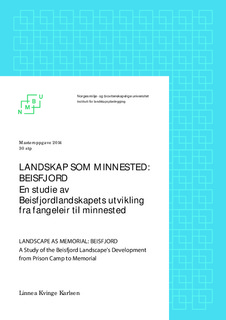| dc.description.abstract | Denne masteroppgaven omhandler Beisfjord som landskap og minnested.
Beisfjord i Nordland var åsted for den verste og mest brutale fangeleiren i Norge under andre verdenskrig. I perioden 1942-1945 var det både jugoslaviske og sovjetiske fanger i leiren. I ettertid er det blitt etablert et minnested, men stedet formidler ikke historien godt nok.
Oppgavens hovedproblemstilling går ut på hvordan Beisfjordlandskapet har utviklet seg fra tiden før fangeleiren ble etablert og fram til i dag. En underproblemstilling til dette spør hvordan Beisfjord kan og bør utvikles som minnested.
Første del av oppgaven er en introduksjon. Deretter presenteres en teoridel om minnekultur og minnesteder, og så en hoveddel som gjennomgår informasjon fra fangeleirtiden og frem til i dag. Den fjerde delen omhandler tanker for videre utvikling av minnestedet, mens den femte delen er en avslutning på oppgaven.
Beisfjord har utviklet seg fra å være en liten og fredelig bygd til å bli åsted for en fangeleir preget av sykdom, vold og død. Fangene “levde” i landskapet. Det samme landskapet omkranser minnestedet i dag.
Fortsatt finnes det autentiske spor fra fangeleirtiden. Disse ligger hovedsakelig innimellom bebyggelsen som i dag finnes i området. Sporene beviser realiteten og knytter fortiden sterkere til nåtid og fremtid.
Bevisstheten rundt funksjoner i leiren, historier og deres tilknytning til landskapet forsterker mulighetene for å utvikle et mer formidlende minnested. Sentrale deler av leiren var veiene, appellplassen, brakkene, vakttårnene og leirgrensen. Samtidig knyttet leiren seg sterkt til kommandantboligen, gravene som ble etablert, elven og annen omkringliggende natur.
Den delen av leiren hvor fangene bodde opptok omtrentlig halve leirområdet. Denne delen lå på det området som i dag er en åpen grusplass (tidl. idrettsplass). Her står man friere til å kunne gjøre noe mer ut av minnestedet.
ABSTRACT:
This master thesis is about Beisfjord as a landscape and a memorial.
Beisfjord in Nordland was the site of the worst and most brutal prison camp in Norway during World War II. In the period of 1942-1945 there were both Yugoslav and Soviet prisoners in the camp. In retrospect, a simple memorial has been made, but it does not convey the story well enough.
The main question of the thesis is how the Beisfjord landscape has evolved from the days before the camp was established to the present. A sub question to this asks how Beisfjord can and should be developed as a memorial.
The first part of the thesis is an introduction. Then, a theoretical part about memory culture and different memorials is presented. The main part about the landscape’s development from the prison camp period until the present follows. The fourth part of the thesis deals with thoughts on further development of the memorial, while the fifth part concludes the work.
Beisfjord has evolved from being a small and peaceful village to becoming the site of a horrific prison camp. The prisoners “lived” in the landscape. The same landscape surrounds the memorial today.
There are still authentic traces from the prison camp period. These are mainly located in between the residential houses that currently exist in the area . The traces prove the reality of history and relate the past to present and future.
Awareness of the functions that existed within the prison camp, the stories and their connection to the landscape enhances the possibilities of developing a more communicative memorial. Key features of the camp were the roads, “the square”, the barracks, the guarding towers and the fences around the camp. The camp was also strongly linked to the hut where the camp commander lived, the graves around the camp, the river and other surrounding nature elements.
The part of the camp where the prisoners lived occupied approximately one half of the camp area. This part was in the area that today is an empty space (former sports field). Here, there is great potential to make something more out of the memorial. | nb_NO |

